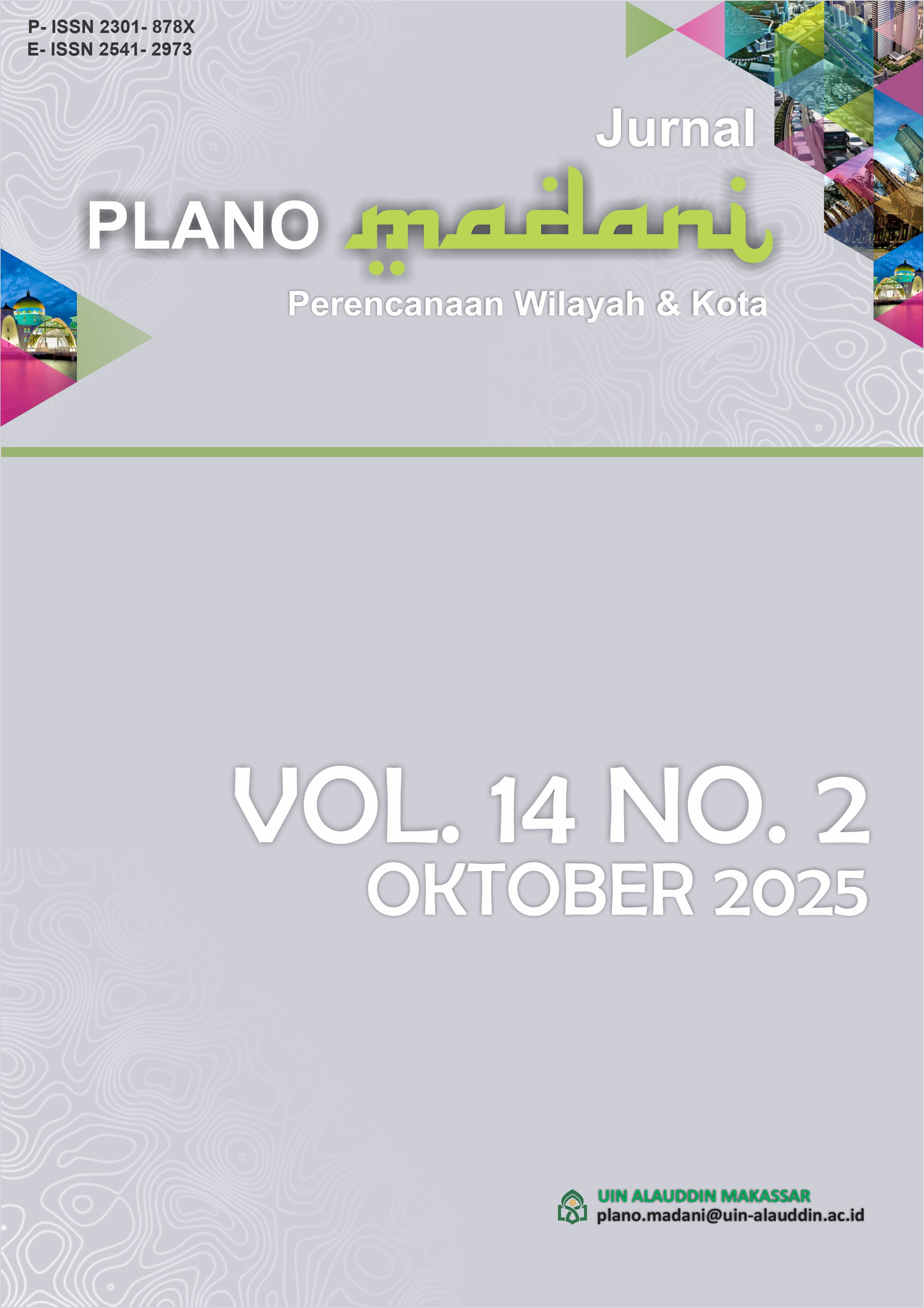MAPPING OF FLOOD-PRONE AREAS AND AGRICULTURAL LAND MANAGEMENT STRATEGIES IN PALOPO CITY
Keywords:
Flood, Map, Palopo City, VulnerabilitAbstract
The research on flood-prone areas based on Geographic Information Systems (GIS) for disaster mitigation efforts is crucial due to the rapid and irregular development in the suburban areas, which leads to cities becoming prone to disasters. The objective of this study is to determine the extent of flood-prone areas through flood vulnerability mapping, in order to optimize flood impact mitigation efforts on Sustainable Agricultural Land in Palopo City. The research location is Palopo City. The research method used is the scoring and overlay method on 6 parameters for 5 categories of flood vulnerability. The analysis results of flood-prone areas in Palopo City show a flood vulnerability map with the following area classifications: vulnerable (16,725.33 ha), fairly safe (7,864.23 ha), moderately vulnerable (2,158.49 ha), safe (924.03 ha), and very vulnerable (71.92 ha). The generated map provides information about flood-prone areas to the Palopo City government, especially the Regional Disaster Management Agency and the Agriculture, Livestock, and Plantation Department of Palopo City
Downloads
References
Aziza, S, N., Somantri, L., & Setiawan, I. (2022). Analisis Pemetaan Tingkat Rawan Banjir Di Kecamatan Bontang Barat Kota Bontang Berbasis Sistem Informasi Geografis. Jurnal Pendidikan Geografi Undiksha. 9 (2), 109-120.
Cakit, E., & Karwowski, W. (2018). A fuzzy overlay model for mapping adverse event risk in an active war theatre. Journal of Experimental & Theoretical Artificial Intelligence., 30 (5), 691-701.
Chowdhuri, I., Pal, S. C., Saha, A., Chakrabortty, R., & Roy, P. (2021). Evaluation of Different DEMs for Gully Erosion Susceptibility Mapping Using In-Situ Field Measurement and Validation. Ecol. Journal on Computational Ecology and Ecological Data Science, 65, 101425.
Darmawan, K., Hani’ah, H., & Suprayogi, A., Analisis Tingkat Kerawanan Banjir Di Kabupaten Sampang Menggunakan Metode Overlay Dengan Scoring Berbasis Sistem Informasi Geografis. Jurnal Geodesi Undip, 6 (1), 31-40.
De Almeida, L. Q., Welle, T., & Birkmann, J. (2016). Disaster Risk Indicators in Brazil: A Proposal Based On The World Risk Index. International Journal of Disaster Risk Reduction., 17, 251–272.
Fauzi, A, R., (2022). Analisis Tingkat Kerawanan Banjir Kota Bogor Menggunakan Metode Overlay dan Scoring Berbasis Sistem Informasi Geografis. Jurnal Geomedia, 20 (2), 96 – 107.
Ferdi., Maliki, R,. Z., & Saputra, I. A., (2021). Flood Hazard Mapping in Baolan, Tolitoli District, Central Sulawesi. Jurnal Dialog Penanggulangan Bencana, 12 (1), 13-20.
Hadi, H., Agustina, S., & Subhani, A. (2019). Penguatan Kesiapsiagaan Stakeholder dalam Pengurangan Risiko Bencana Gempabumi. Jurnal Geodika, 3 (1), 30–40.
Harisuseno, D., & Bisri, M. (2017). Limpasan Permukaan Secara Keruangan: Spatial Runoff. Malang: Universitas Brawijaya Press.
Hidayah, E., Widiarti, W. Y., Ammarulsyah, A. R. (2022). Zonasi Tingkat Kerawanan Banjir Bandang dengan Sistem Informasi Geografis di Sub-DAS Kaliputih Kabupaten Jember. Jurnal Teknik Pengairan: Journal of Water Resources Engineering, 13(2), 273-282.
Hidayat, W, Rustiadi E, Kartodihardjo H. (2015) The Impact of Mining Activity on Land Use Change and Suitability of Space Utilization: The Case of East Luwu Regency, South Sulawesi Province. Journal of Regional and City Planning. 26 (2), 130–46.
Irawan, T., & Budi Yuwono, S. (2016). Infiltrasi Pada Berbagai Tegakan Hutan di Arboretum Universitas Lampung. Jurnal Sylva Lestari, 4 (3), 21-29.
Krisnantara, G., Karondia, L, A., Wahyudi, I., & Dani, M, F., (2021). Kajian Kerawanan Longsor Lahan di Kabupaten Berau Berbasis Sistem Informasi Geografis. Jurnal Penelitian Pendidikan Geografi 6 (2), 92–103.
Kusumo, P., & Evi Nursari. (2016). Zonasi Tingkat Kerawanan Banjir Dengan Sistem Informasi Geografis Pada DAS Cidurian Kab. Serang, Banten. STRING (Satuan Tulisan Riset dan Inovasi Teknologi) 1 (1): 29–38.
Miswarti., Maidawilis., Gusni, J., Eni, R., Hasmita., (2023). Penanganan Kesehatan Jiwa pada Korban Bencana. Jurnal Pengabdian Masyarakat Indonesia (JPMI), 2 (2), 212-222.
Romshoo, S, A., Yousuf, A., Altaf, S., & Amin, M. (2021). Evaluation of Various DEMs for Quantifying Soil Erosion Under Changing Land Use and Land Cover in the Himalaya. Journal Frontiers in Earth Science. 9:782128.
Suarmika, P. E., Putu Arnyana, I. B., Suastra, I. W., & Margunayasa, I. G. (2022). Reconstruction of Disaster Education: The Role of Indigenous Disaster Mitigation For Learning in Indonesian Elementary Schools. International Journal of Disaster Risk Reduction, 72, 102874.
Siringoringo G. L. R., (2022). Program dalam Pelaksanaan Tujuan Pembangunan Berkelanjutan (SDGs) dalam Hal Masalah Perubahan Iklim di Indonesia. Jurnal Kajian Ilmu dan Pendidikan Geografi, 5 (1), 43-52.
Widiawaty, M. A., Dede, M., & Ismail, A. (2018). Kajian komparatif pemodelan air tanah menggunakan sistem informasi geografis di Desa Kayuambon, Kabupaten Bandung Barat. Jurnal Pendidikan Geografi, 18 (1). 63-71.
Salinan Lampiran Peraturan Menteri Riset, Teknologi, Dan Pendidikan Tinggi (2019). Republik Indonesia Nomor 38 Tahun 2019 Tentang Prioritas Riset Nasional Tahun 2020- 2024
Downloads
Published
How to Cite
Issue
Section
License
Copyright (c) 2025 Wahyu Hidayat

This work is licensed under a Creative Commons Attribution-NonCommercial-ShareAlike 4.0 International License.
By Submitting your manuscript to our journal, your are following Copyright & License








